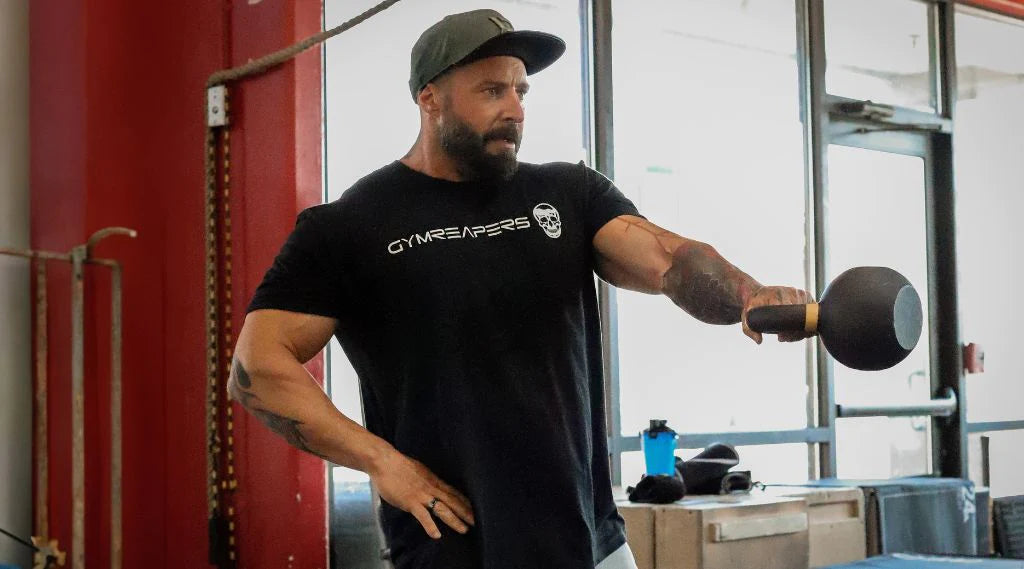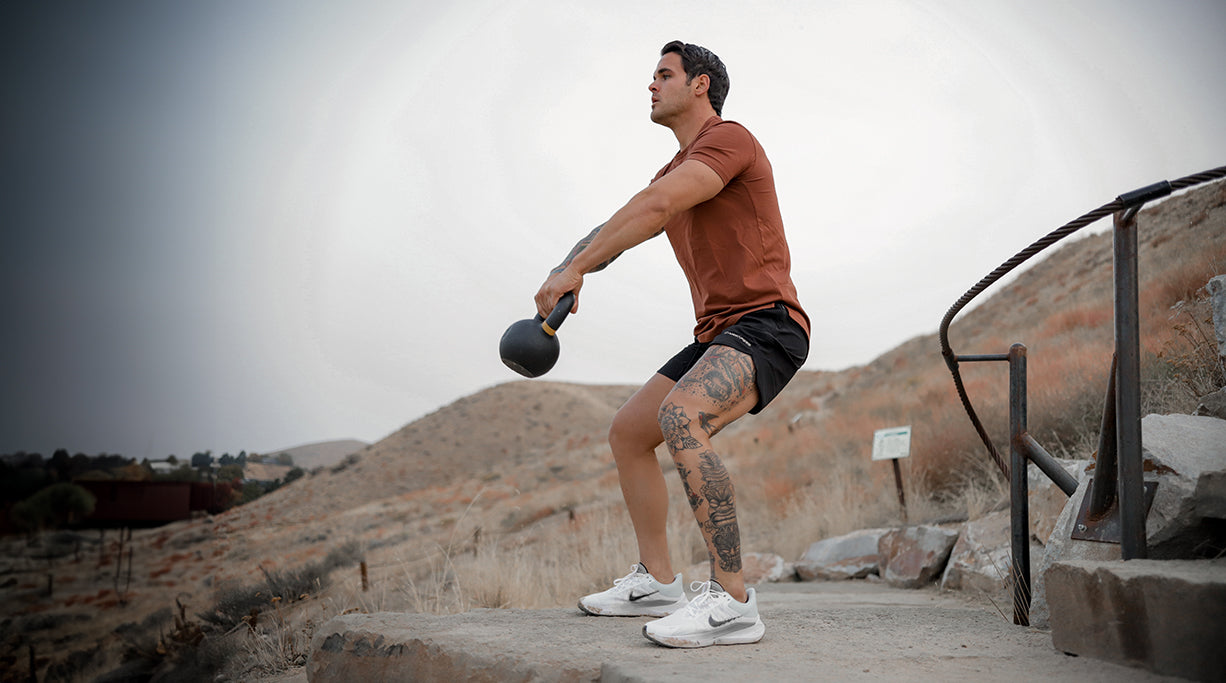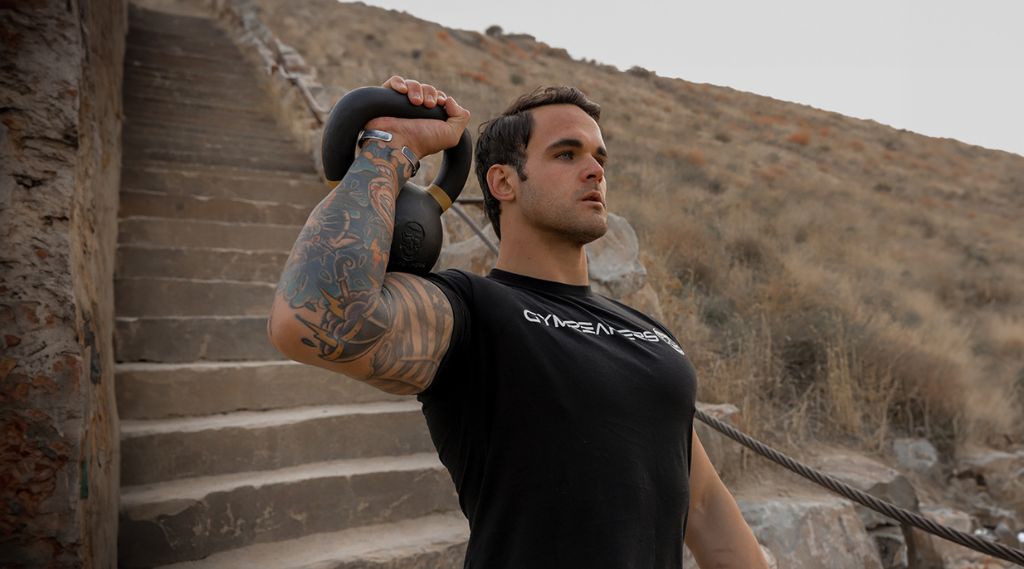If you’re looking for more exercises to do with your kettlebell then a single-arm swing is a great option. As an experienced personal trainer, I’ve taught the single-arm kettlebell swing countless times, so I can teach you how to do it the right way.
The one-arm kettlebell swing should be a staple in your routine because it develops many major muscle groups at once, builds full-body strength, power, and stability, burns calories, improves endurance, reduces the risk of muscle imbalances, and promotes better posture.
The benefits of the single arm kettlebell swing can only be unlocked if you’re performing the movement correctly and avoiding the 7 most common mistakes. To help set you up for success, I’ll teach you exactly how to perform the movement and how to fix these mistakes.
Key Takeaways
Kettlebell Single Arm Swing: Anatomy Overview

Single-arm kettlebell swings are fantastic for building whole-body strength, power, and stability by targeting multiple major muscle groups. Let’s take a look:
Gluteus Maximus
The gluteus maximus is the largest and most powerful muscle in the body. Its primary role during kettlebell swings is to produce hip extension (driving the hips forward and allowing trainees to stand tall at the top of each repetition).
Hamstrings
The hamstrings make up the rear portion of the thighs and work together with the glutes to produce hip extension.
Quadriceps
The quads make up the front part of the thighs, and their primary function is knee extension (straightening of the legs). One of the four quad heads, the rectus femoris, also crosses the hip joint and contributes to hip flexion as the kettlebell travels back and between the legs.
Erector Spinae
The erector spinae are long muscles that run along both sides of the spine. Their primary function is to straighten the back and keep it in a strong position, especially during dynamic compound lifts like kettlebell swings.
Latissimus Dorsi
The latissimus dorsi (or ‘lats’) are the largest muscles in the upper body, making up a significant portion of the mid and upper back.
Their primary functions are to promote shoulder stability, help control the kettlebell as it swings back, and produce force to thrust the kettlebell forward.
Trapezius
The trapezius is a large upper back muscle that stabilizes the shoulder girdle and is necessary for scapular elevation (i.e., shrugging your shoulders).
In the context of single-arm swings, the traps primarily support the shoulders, ensuring a strong and stable position.
Shoulders
The shoulders, also known as the deltoids, work with the lats to control the kettlebell as it swings backward and produces force to lift it in front of the body at the top of each repetition.
Rotator Cuff
The rotator cuff consists of four small muscles (supraspinatus, infraspinatus, teres minor, and subscapularis) that are essential for shoulder stability and health. Along with the deltoids, these muscles control the movement at the shoulder joint, reducing the risk of injuries.
Midsection
The midsection includes the rectus and transversus abdominis, obliques, and other muscles that promote torso rigidity and keep the spine in a healthy position.
7 Benefits Of Single-Arm Kettlebell Swings

The benefits of single-arm kettlebell swings include:
1. Trains Multiple Muscles At Once
The single-arm kettlebell swing helps you maximize your time in the gym by targeting multiple muscle groups (discussed above) at once. This makes it ideal for those who are training less frequently or have a limited amount of time to spend at the gym.
The single-arm kettlebell swing effectively trains most of the upper and lower body, promoting a solid training stimulus for whole-body strength and hypertrophy.
2. Builds Endurance & Promotes Fat Loss
High-rep training works well for kettlebell swings, which allows trainees to build endurance, improve their aerobic capacity, and burn extra calories.
As such, the movement is fantastic for everyone looking to develop functional fitness and lose excess body fat.
3. Improves Core Stability
The rectus and transversus abdominis, obliques, glutes, erector spinae, and other major muscles engage during kettlebell swings to promote torso stability and to keep the spine in a healthy position.
As a result, core stability improves, translating to better overall training performance, reduced risk of injury, and more athleticism.
Plus, doing the exercise with one arm at a time is a great way to build anti-rotational strength, which means you can more effectively resist external forces trying to pull you in a specific direction.
4. Strengthens the Shoulders
We can move our arms freely in almost all directions thanks to the exceptional mobility of the shoulder joint. Sadly, that freedom of movement also means the shoulders are less stable and more prone to damage, especially during sudden movements.
“Swinging the kettlebell with one arm rather than two puts extra demands on the shoulder and also attempts to pull the body into rotation. Your shoulder stabilizing muscles will have to work much harder in order to keep your shoulder in good position and prevent the arm from being pulled from its socket. ”
-Greg Brookes, Personal Trainer
Controlled kettlebell swings strengthen the deltoids and rotator cuff muscles, resulting in more stable and resilient shoulders.
5. Develops Power and Explosiveness
The kettlebell swing is a dynamic exercise that requires a rapid change of direction, which helps you develop power and explosiveness, especially in the posterior chain. These athletic characteristics are valuable and can enhance your performance in and out of the gym.
6. Addresses Muscle Imbalances
Performing the exercise with one arm at a time allows trainees to work both sides of the body more effectively, reducing the risk of side-to-side muscle imbalances.
7. Improves Posture
Strengthening the posterior chain and midsection musculature by performing single-arm kettlebell swings promotes better posture and spinal alignment, which could reduce the risk of nagging back or neck pain down the road.
How To Do Kettlebell Single Arm Swings
Follow these steps to perform single-arm swings properly:
- Stand with your feet roughly hip-width apart and toes pointing slightly out.
- Position a kettlebell in front of you.
- Squat down to grip the kettlebell’s handle with one hand. Keep your chest out, your back in a neutral position, and your arm straight.
- With your body in a tight position, inhale, and engage your abs.
- Initiate the swing by pulling the kettlebell back between your legs.
- Immediately drive your hips forward to stand up and allow that momentum to propel the kettlebell out in front of you.
- Keep your arm straight and allow the kettlebell to reach chest height, but not higher. Exhale as the weight reaches the top of the rep.
- Control the kettlebell’s free fall in the opposite direction, guiding it between your legs as you bend your knees and hips. Maintain a neutral back throughout the motion.
- Inhale immediately and rapidly change the weight’s direction, moving it forward as you extend your hips.
- Once finished training one side, grab the weight with your other hand and repeat.
7 Common Mistakes With Kettlebell Single Arm Swings & How To Fix Them

To ensure you’re getting the most out of your swings and staying injury-free, it’s important to be aware of these common mistakes and how to fix them.
1. Using Your Arms to Swing the Kettlebell
One of the most common mistakes with the kettlebell swing is trying to lift the kettlebell up by bending and extending the arms.
Doing so can lead to excessive joint stress, kill your momentum, and limit how much weight you can use. The secret to a proper kettlebell swing comes from generating momentum at the hips rather than lifting with the arms.
How to Fix
Generate the force for the swing by forcefully extending your hips immediately after the kettlebell moves between your legs. Focus on elevating the kettlebell using momentum from your hips and using your arms simply to follow through.
2. Bending Your Knees Too Much
Some degree of knee flexion and extension is normal and to be expected during a kettlebell swing, but this is still primarily a hip hinge activity rather than a squat. The majority of the movement should occur at the hips, and you should feel the tension in your posterior chain.
Feeling too much tension in your quadriceps likely means you’re bending your knees more than necessary.
How to Fix
Video yourself performing the movement from a side view and watch to see how much you’re bending your knees. If the movement resembles a squat more than a hinge at the hips, then work on shifting your hips backward and keeping your knees more stable during the swing.
3. Raising the Kettlebell Too High
The kettlebell swing is a hip hinge movement that primarily targets the posterior chain. Lifting the weight above chest level is unnecessary because you achieve full hip extension and peak posterior chain activation when the kettlebell is at chest height.
Raising the weight higher doesn’t offer any additional benefits but it can affect your technique and make it more difficult to control the kettlebell on the way back.
How to Fix
Keep each repetition controlled and avoid using your arms to raise the weight above chest level. If you’re generating so much momentum on the swing upward that you’re naturally going above chest level, then choose a heavier kettlebell.
4. Arching Your Lower Back at the Top
Trainees often allow their lower back to arch at the top of the swing through hyperextension (driving the hips too far forward). Hyperextension places unnecessary stress on the spine and can result in nagging aches or serious injury.
How to Fix
Keep your repetitions controlled by engaging your abs as you lock out your hips, this will help keep you in a stacked position at the top of each swing rather than hyperextended.
5. Not Keeping Your Working Arm Straight
No elbow flexion or extension should occur in the working arm at any point during a kettlebell swing. If your elbow is bending during the swing, this would indicate that you’re not engaging your posterior chain effectively and are instead trying to lift the weight with your arms and shoulders.
How to Fix
Flex your tricep to keep your arm almost entirely straight, and engage your posterior chain to drive your hips forward and create momentum.
6. Allowing Your Lower Back to Round at the Bottom
Lower back rounding is common during hip hinge exercises, including more dynamic ones like the kettlebell swing. Lower back rounding means that your spine is flexing, which can lead to nagging aches or more serious injuries.
How to Fix
Engage your abs and erectors at the start of each set and maintain that tightness until the last rep. Also, learn to hinge at the hips and load your hamstrings effectively.
If you lack body awareness and have not yet mastered the hip hinge, then take a step back from kettlebell swings until you have.
7. Not Breathing Correctly
Breathing can be difficult during more dynamic exercises because repetitions often blend together. As a result, trainees often aren’t sure when to inhale and exhale.
Unfortunately, irregular breathing can affect performance, especially on high-rep sets, and impact trainees’ ability to maintain core tightness.
How to Fix
Start with slower, less explosive repetitions to sync your breathing with each repetition. Inhale as the kettlebell swings back, and forcefully exhale as you drive your hips forward and the weight reaches the top of each rep.
Once you've mastered the breathing technique, you can push yourself harder in your single arms swings.
Kettlebells For Single Arm Swings

You can pick from multiple weight options of kettlebells, ranging from 4 to 40 kilograms (9 to 88 lbs), which means there is a kettlebell for you, no matter how experienced (or inexperienced) you are.
Kettlebells can also be used for far more than swings. They are ideal for other dynamic exercises like snatches and more traditional gym activities like overhead presses and goblet squats.
To top it all off, kettlebells look great and come with kilogram and pound imprints, allowing you to easily see how much weight you’ve picked up and track your progress over time.













Leave a comment
All comments are moderated before being published.
This site is protected by hCaptcha and the hCaptcha Privacy Policy and Terms of Service apply.